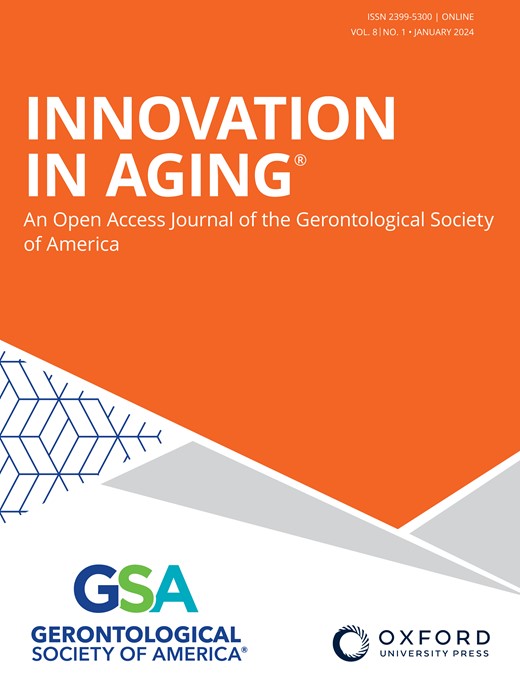INTERDISCIPLINARY WELLNESS CLINICS IN LOW-INCOME SENIOR HOUSING COMMUNITIES
IF 4.9
3区 医学
Q1 GERIATRICS & GERONTOLOGY
引用次数: 0
Abstract
Abstract Low-income older adults may qualify to live in subsidized housing via the Housing and Urban Development (HUD) Section 202 program. Established in 1959, Section 202 is the only HUD program that provides housing exclusively for older adults. More than 1.8 million older adults receive this type of federal housing assistance. Older adults living in low-income senior housing communities are mostly people of color, socioeconomically disadvantaged, and at risk for poor physical and mental health and adverse health outcomes. Additionally, they have limited access to healthcare services and other resources such as internet use, healthy food options, opportunities for physical activity, and safe indoor and outdoor physical environments. Further they are at increased risk of high emergency room utilization and transfer to nursing home settings. The purpose of this project was to develop Interdisciplinary Wellness Clinics for older adults living in low-income senior housing communities and provide direct services including such things as blood pressure monitoring, medication management, hearing evaluation and cerumen removal, foot and nail care, pain management, management of acute medical problems, immunizations, and Medicare Annual Wellness Visits. Interdisciplinary Wellness Clinics are provided monthly to four low-income senior housing communities and serve approximately 500 residents living in these communities. This symposium will provide a review of residents seen and services provided with a focus on findings identified and interventions implemented; a description of the Medicare Annual Wellness services; and a review of approaches used to engage residents in using these services.低收入老年住房社区的跨学科健康诊所
摘要 低收入老年人可以通过住房和城市发展部(HUD)的第 202 款计划获得住在补贴住房的资格。第 202 款于 1959 年制定,是住房和城市发展部唯一专门为老年人提供住房的计划。有 180 多万老年人接受此类联邦住房援助。居住在低收入老年住房社区的老年人大多是有色人种,在社会经济方面处于不利地位,面临身心健康状况不佳和不良健康后果的风险。此外,他们获得医疗保健服务和其他资源(如互联网使用、健康食品选择、体育活动机会和安全的室内外物理环境)的机会有限。此外,他们使用急诊室和转入疗养院的风险也在增加。该项目的目的是为居住在低收入老年住宅社区的老年人建立跨学科健康诊所,并提供直接服务,包括血压监测、药物管理、听力评估和耵聍清除、足部和指甲护理、疼痛管理、急性病管理、免疫接种和医疗保险年度健康检查等。跨学科健康诊所每月为四个低收入老年住宅社区提供服务,服务对象包括这些社区的约 500 名居民。本次研讨会将对居民就诊情况和所提供的服务进行回顾,重点关注所发现的问题和所实施的干预措施;介绍医疗保险年度健康服务;并对吸引居民使用这些服务的方法进行回顾。
本文章由计算机程序翻译,如有差异,请以英文原文为准。
求助全文
约1分钟内获得全文
求助全文
来源期刊

Innovation in Aging
GERIATRICS & GERONTOLOGY-
CiteScore
4.10
自引率
0.00%
发文量
72
审稿时长
15 weeks
期刊介绍:
Innovation in Aging, an interdisciplinary Open Access journal of the Gerontological Society of America (GSA), is dedicated to publishing innovative, conceptually robust, and methodologically rigorous research focused on aging and the life course. The journal aims to present studies with the potential to significantly enhance the health, functionality, and overall well-being of older adults by translating scientific insights into practical applications. Research published in the journal spans a variety of settings, including community, clinical, and laboratory contexts, with a clear emphasis on issues that are directly pertinent to aging and the dynamics of life over time. The content of the journal mirrors the diverse research interests of GSA members and encompasses a range of study types. These include the validation of new conceptual or theoretical models, assessments of factors impacting the health and well-being of older adults, evaluations of interventions and policies, the implementation of groundbreaking research methodologies, interdisciplinary research that adapts concepts and methods from other fields to aging studies, and the use of modeling and simulations to understand factors and processes influencing aging outcomes. The journal welcomes contributions from scholars across various disciplines, such as technology, engineering, architecture, economics, business, law, political science, public policy, education, public health, social and psychological sciences, biomedical and health sciences, and the humanities and arts, reflecting a holistic approach to advancing knowledge in gerontology.
 求助内容:
求助内容: 应助结果提醒方式:
应助结果提醒方式:


